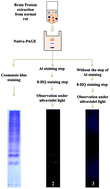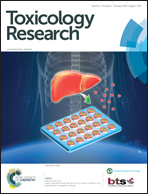Identification of the Al-binding proteins that account for aluminum neurotoxicity and transport in vivo†
Abstract
Studies have shown that aluminum (Al) is the most abundant neurotoxic element on Earth, and is implicated in the pathogenesis of Alzheimer's disease (AD). However, the mechanisms underlying Al-induced neurotoxicity are still largely elusive. Based on affinity analyses with Al and LC-LTQ-MS, we have found that serum albumin, brain CK-B and 14-3-3ζ protein have a high affinity for Al3+, and albumin has a much stronger affinity for Al than transferrin. The normal activity of CK-B, and physiological combination of 14-3-3ζ with tau can be severely perturbed by Al. We anticipate that our assay will provide a new focus concerning the mechanism underlying Al-induced neurotoxicity, and aid the design of strategies to prevent AD and other human diseases related to Al overload.



 Please wait while we load your content...
Please wait while we load your content...